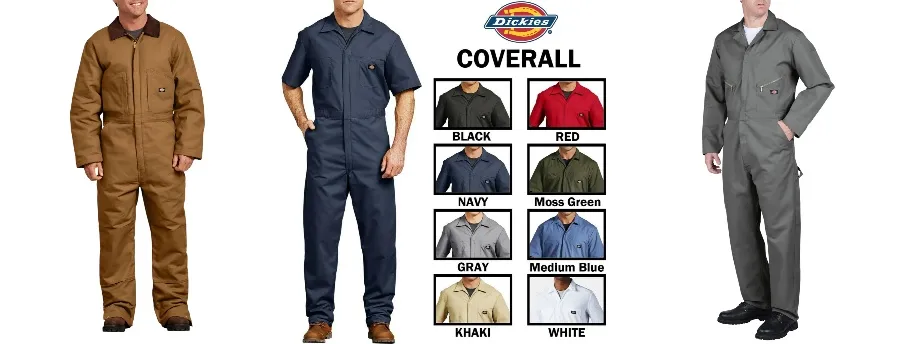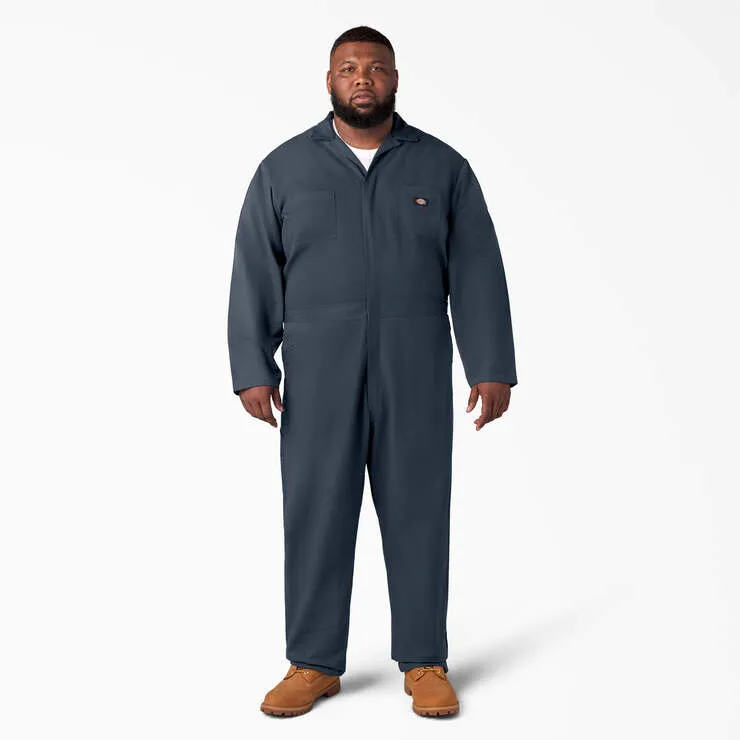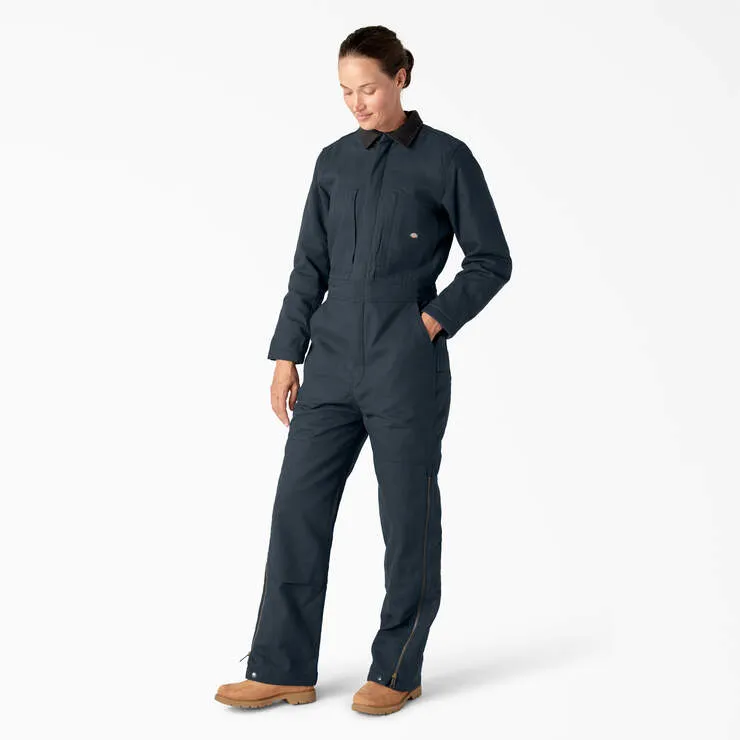Working long hours on a job site means your clothing has to do more than just cover you. Many workers choose Dickies Coveralls because they bring durability, protection, and a timeless design. Based on my own experience, I’ll break down the key strengths and weaknesses to help you figure out if they’re right for you. Whether you’re in construction, auto repair, or farming, you’ll get a clear idea of who these Dickies coveralls are really built for.
Advantages of Dickies Coveralls: Durability, Comfort, and Protection
Dickies coveralls stand out for their durable fabric, blending 65% polyester with 35% cotton poplin. This mix ensures the coveralls last through tough jobs and repeated industrial washing, while still providing comfortable wear.
1. Durable, Stain-Resistant Fabric of Dickies Work Coveralls
The fabric includes stain-release technology, making it easier to clean off grease, paint, and dirt. This means less time spent on maintenance and more time focused on work.
2. Thermal and Weather Protection of Dickies Work Coveralls
Dickies coveralls offer excellent thermal insulation, helping to keep workers warm during cold-weather jobs. Their wind-resistant design also shields wearers from harsh outdoor conditions.
3. Full-Body Safety and Convenience of Dickies Work Coveralls
Coveralls provide full coverage for arms, legs, and torso, protecting against dirt, chemicals, and sparks. Many models feature a 5-pocket design that holds tools and personal items, improving work efficiency by reducing the need for extra tool belts.
4. Easy to Wear and Flexible Fit of Dickies Work Coveralls
Designed for ease of use, Dickies coveralls have front zipper closures and concealed snaps for quick on-and-off changes. The bi-swing back and roomy shoulders allow unrestricted movement, while elastic waist inserts provide a flexible, comfortable fit.
5. Wrinkle Resistance and Industrial Wash Durability of Dickies Work Coveralls
Some Dickies coveralls resist wrinkles, maintaining a neat appearance with little ironing. They also withstand industrial washing without losing color or fabric strength, ensuring long-term reliability.
6. Versatility Across Professions of Dickies Work Coveralls
Suitable for construction, mechanical work, manufacturing, medical settings, and fire safety, Dickies coveralls combine protection, comfort, and practical features to meet varied workplace demands.
User Feedback and Performance of Dickies Work Coveralls
- Users praise the coveralls for durability and ease of cleaning during both professional and DIY projects like auto repair or painting.
- Insulated coveralls keep wearers warm for up to 8 hours in freezing temperatures, especially when layered.
- Common models include 4 to 6 pockets for convenient tool storage.
In summary, Dickies coveralls deliver durable protection, comfort, and practical features ideal for demanding jobs in different environments.
Cons of Dickies Coveralls: Durability, Fit, and Price Concerns
While Dickies work coveralls offer good value for many users, several drawbacks are worth noting.
1. Durability of Dickies Work Coveralls Compared to Premium Brands
Dickies coveralls are less durable than top workwear brands like Carhartt. Their materials and construction wear out faster, especially under tough conditions. For heavy-duty jobs or abrasive environments, they may not hold up well. For example, the lighter fabric can struggle with demanding tasks like construction or cold outdoor work.
2. Limited Protection in Extreme Weather of Dickies Work Coveralls
Standard Dickies coveralls usually lack insulation. This means they may not keep you warm enough in very cold or wet conditions. Although insulated versions exist, many users find the regular models insufficient for winter. One reviewer said, “The one I purchased isn’t lined with anything, so in the winter I’ll still have to wrap up.”
3. Quality Control and Sizing Issues of Dickies Work Coveralls
Common complaints include zipper problems. Some users report zippers that fail or don’t work smoothly, reducing usability on the job. Sizing options are limited as well. Most coveralls come in standard lengths, forcing many people to alter the legs for a better fit. Larger sizes are also scarce, which can exclude some body types.
4. Visible Branding and Price Increase of Dickies Work Coveralls
Dickies’ large logo is very noticeable, which may bother users seeking a subtle look. Additionally, the price of Dickies coveralls has risen significantly—up to 40% over the last decade, according to customer reports.
Summary of Key Cons
- Less durable than premium workwear brands in heavy use
- Insufficient insulation for harsh cold or wet weather in standard models
- Frequent zipper issues are reported by users
- Limited sizing, requiring alterations for many
- Prominent, visible brand logo
- Notable price increases over time
Overall, Dickies coveralls work well for light to moderate jobs but have drawbacks in durability, fit, weather protection, and cost.
Dickies Coveralls Size Chart and Fit Guide
Dickies work coveralls come in a wide range of sizes for both men and women, designed to fit various body types and work needs. This makes them a practical choice for many users looking for comfort and functionality.
Men’s Dickies Coveralls Sizing
Men’s Dickies coveralls are sized mainly by chest and neck measurements:
| Size | Chest | Neck |
|---|---|---|
| S | 34–36″ | 14–14.5″ |
| M | 38–40″ | 15–15.5″ |
| L | 42–44″ | 16–16.5″ |
| XL | 46–48″ | 17–17.5″ |
| 2XL | 50–52″ | 18–18.5″ |
| 3XL | 54–56″ | 19–19.5″ |
| 4XL | 58–60″ | 20–20.5″ |
| 5XL | 62–64″ | 21–21.5″ |
| Up to 7XL (select styles) | 70–72″ | 23–23.5″ |
Men’s coveralls also offer different length options to fit different heights:
Short length
Regular length
Tall length
Big & Tall options starting at 46″ waist or length
Women’s Dickies Coveralls Sizing
Women’s Dickies coveralls use numeric sizes based on chest, waist, and hip measurements:
| Size | Chest Measurement |
|---|---|
| XS (2/4) | 34.5″ |
| S (6/8) | 36.5″ |
| M (10/12) | 39″ |
| L (14/16) | 42″ |
| XL (18/20) | 46″ |
| 2XL (22/24) | 50″ |
Women’s pants sizes cover:
Waist: 27.5″ to 43″
Hips: 37.5″ to 56″
Tips for Measuring and Choosing the Right Fit
To find the best fit, follow these simple measurement tips of Dickies safety coveralls:
Measure the fullest part of the chest, keeping the tape under the arms and level across the back.
Measure the neck circumference around the base of the neck.
Measure sleeve length from the shoulder to the wrist with the arm slightly bent.
Fit and Comfort
Dickies coveralls are known for a generous fit that allows easy movement and layering over other work clothes. Their size variety, including Big & Tall versions, supports a wide range of body shapes and sizes. For example:
- A man with a 42″ chest and 16″ neck fits well in size L.
- A woman with a 32″ waist and 42″ hips should choose size 12.
This broad size selection ensures most users can find a comfortable and functional coverall that fits well.
Who Uses Dickies Coveralls? Prospective Buyers and Typical Users
Dickies coveralls are popular among various groups thanks to their durable design and practical features. Here’s a breakdown of who typically wears them:
Skilled Trades and Industrial Workers
Workers such as electricians, plumbers, mechanics, welders, and construction professionals heavily rely on Dickies coveralls. These users need strong fabric and reinforced stitching that protects against dirt, chemicals, and abrasions. The coveralls’ multiple pockets and easy tool access make them especially practical on the job.
Factory and Warehouse Staff
Employees in factories and warehouses choose Dickies for protective, easy-care uniforms. The coveralls offer a good balance of protection and comfort during long shifts.
Creative Professionals and Musicians
Artists and musicians working in studios or on stage find Dickies functional and suited for active work environments. The work coveralls provide freedom of movement while maintaining a rugged look.
Youth and Streetwear Enthusiasts
A growing number of young adults and teenagers, especially those involved in skateboarding, dance, and streetwear culture, wear Dickies as a style statement. In the US, 20-25% of Dickies sales come from this group, drawn by its blue-collar aesthetic linked to music subcultures like punk and hip hop. In China, over half of Dickies’ customers are Gen Z fans attracted to the brand’s industrial-chic style connected to hip hop and creative arts.
Women
More women are choosing Dickies coveralls for both utility and fashion. The brand offers Dickies Girl apparel designed to meet practical needs while maintaining style. However, Dickies avoids drastic style changes to keep its core customers satisfied.
Summary of Primary Users
- Skilled tradespeople: electricians, plumbers, mechanics, welders, construction workers
- Factory and warehouse workers
- Artists and musicians
- Skateboarders, dancers, and streetwear fans
- Students and young adults value heritage style and durability
- Women seeking practical or fashionable workwear
With its combination of durability, practicality, and cultural appeal, Dickies coveralls serve not just as protective workwear but also as a symbol of resilience and self-expression.
Customer Ratings and Feedback on Dickies Coveralls
Dickies coveralls have a strong reputation, with average customer ratings ranging from 4.3 to 4.6 out of 5 stars across popular retail platforms.
Dickies Men’s and Big Men’s Deluxe Cotton Long Sleeve Coveralls:
4.5 stars (136 ratings, 112 reviews)
Dickies Workwear Overalls & Coveralls Heavy-Duty Men’s Big and Tall:
4.6 stars (985 ratings, 399 reviews)
FLEX Long Sleeve Coveralls:
4.3 stars (484 reviews)
Most Mentioned Features and Satisfaction Rates of Dickies Coveralls
Fit and sizing:
37% of reviews talk about it, with 64% positive feedback. Many users find the fit comfortable, but note some inconsistencies in sizing.
Quality issues:
Mentioned in 17% of reviews; 40% positive. Some concerns include flimsy zippers and occasional material weaknesses.
Use Case (work and gardening):
13% mentions with 100% positive feedback. Users appreciate the coveralls for workshop and gardening purposes.
Comfort and breathability:
10% mentions with 100% positive feedback. Lightweight fabric is ideal for hot weather.
Common Praise and Highlights for Dickies Coveralls
- “Value for the money!”
- “Very comfortable!”
- “Great quality and fit.”
- “Sturdy coverall.”
- “Perfect fit, good for summer heat.”
Users especially praise the lightweight, breathable fabric, making these safety coveralls suitable for warm conditions. Durability and sturdy construction stand out, favored by professionals in demanding work environments. The pocket design and functional zippers/buttons also receive positive remarks.
Reported Issues and Suggestions
Sizing inconsistencies: Some find them too baggy or long; many recommend not sizing up.
Quality concerns: Problems with zipper durability and build quality have been noted.
Suggestions include improving workmanship and optimizing pocket layout for better usability.
Customer Satisfaction Overview (Walmart data)
85% of reviewers gave 4 or 5 stars (112 reviews)
Heavy-duty models rated 4 or 5 stars by over 82% of users (399 reviews)
Representative User Comments
“Perfect for your workshop.”
“Modified for gardening.”
“Improvements could be made.”
“Quality appears good, but sizing is a problem.”
Price Range and Buyer Profile
Dickies work coveralls typically start around $18 in prices analyzed, targeting budget-conscious buyers. Most frequent customers are work professionals, gardeners, and people needing summer workwear with comfort and durability.
This feedback paints a clear picture: Dickies coveralls are valued for their comfort, breathability, and durability, especially in hot conditions, though sizing and some quality aspects could use improvement.
Dickies Coveralls Compared to Carhartt and Red Kap
When choosing coveralls, understanding how Dickies stacks up against other popular brands like Carhartt and Red Kap can help you make the best decision for your needs.
Dickies vs. Carhartt: Durability, Comfort, and Price
Durability: Carhartt coveralls are made with heavy duck canvas and reinforced triple-needle seams. This makes them extremely tough and abrasion-resistant, perfect for harsh work environments. Dickies uses poly-cotton blends and duck fabrics that are durable but lighter and easier to break in. Some users find Dickies coveralls a bit stiff at first.
Comfort: Carhartt offers a roomier fit with articulated knees and elbows for better movement. Dickies provides a wider selection of fits, from relaxed to slim. Many Dickies coveralls include moisture-wicking linings and stretch fabrics, plus hidden expandable waistbands for extra comfort and flexibility.
Price: Dickies coveralls are generally $20–$40 cheaper than similar Carhartt models. For workers needing multiple coveralls, Dickies offers great value, while Carhartt’s higher cost reflects its heavy-duty build and longer lifespan.
Dickies vs. Red Kap: Fit, Comfort, and Features
Sizing: Red Kap tends to run smaller than Dickies. If switching brands, it’s often best to size up with Red Kap. Red Kap also focuses more on big and tall sizes, while Dickies covers a broader range from casual to workwear styles.
Comfort: Both brands include moisture-wicking and odor-resistant fabrics. Dickies shorts and coveralls lean toward breathability, while Red Kap’s gear has a more polished look but can feel less airy.
Weather Resistance: Dickies’ Premium Insulated Duck Coveralls offer 6oz. nylon taffeta insulation and water-repellent cotton, making them ideal for cold, wet conditions. Red Kap matches this with its own weather-resistant fabrics and adds snap-on insulated hoods and industrial design features.
Durability: Both brands use reinforced stitching and strong fasteners. For everyday work, they perform similarly in durability.
Price and Value Summary
| Brand | Price Range |
|---|---|
| Dickies | $50–$100 |
| Carhartt | $80–$150+ |
| Red Kap | $50–$110 |
Dickies stand out for affordability, versatile fits, and balanced durability. Carhartt is for those needing the toughest gear and willing to invest more. Red Kap suits workers who want specialized features and precise sizing, especially in industrial settings.
Choosing Dickies is smart for those on a budget or who want lightweight, comfortable coveralls for moderate work conditions.
Frequently Asked Questions About Dickies Coveralls
1. Are Dickies coveralls good for winter?
Standard Dickies coveralls are not insulated, so they may feel too light in freezing weather. For cold jobs, insulated models with thermal lining are a better choice.
2. Do Dickies coveralls shrink after washing?
Most Dickies coveralls use a poly-cotton blend that resists shrinking. To keep the right fit, wash in cold or warm water and avoid high-heat drying.
3. How do you wash and care for Dickies coveralls?
They are machine washable and built for industrial laundry. For oil, grease, or paint stains, pretreat before washing. Many models also have stain-release fabric to make cleaning easier.
4. Can Dickies coveralls be customized with logos?
Yes, many coverall suppliers offer embroidery or patch services. Companies often add their business logos or worker names for a professional look.
5. Where are Dickies coveralls manufactured?
Dickies produces coveralls in different locations, including Mexico, Honduras, and some Asian countries. Production location may vary depending on the specific model.
Conclusion
Dickies coveralls give a solid mix of durability, comfort, and price, making them a smart pick for many types of work. They may not last as long as premium brands like Carhartt, but they stand out for value, easy care, and wide sizing. From mechanics and construction crews to artists and even streetwear fans, people wear them for both work and style. If you need gear that balances function with affordability, Dickies coveralls are worth serious consideration.



